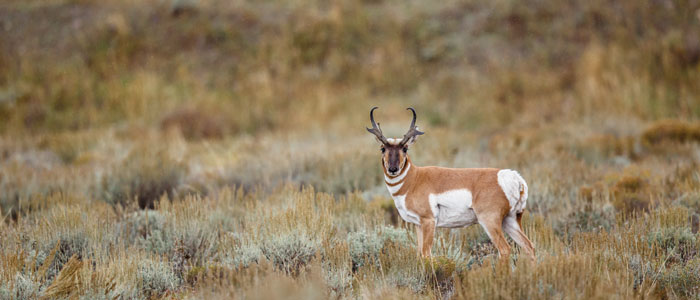

| If you can master the shot, you'll find success in hunting pronghorn. |
If you were casually belly crawling across the prairie without reason, you'd think of crazy stuff. Like, "What will I do if there's a rattlesnake under that next sage bush?" Or, "Why did God make prickly pear, and why did He put it right here?" But when the object of your crawl is wearing long and heavy, heart-shaped horns with 4-inch cutters, there's no nonsense on your mind. You're supremely focused on getting the range and making the shot.
Whether stalking, decoying or sitting in a waterhole, pursuing pronghorn is exhilarating bowhunting. Fooling those keen eyes and ears — and that nose — within bow range is an ultimate hunting challenge.
The question is, when you get there, will you be ready? If all you practice is shooting from a treestand, you won't! To capitalize on that long crawl or sweltering wait, you must master new shots.
The Fluid Prone to Kneeling Shot
Whether you stalk speed goats or decoy them, one of the most common shots you'll take is rising from your belly to your knees while simultaneously drawing and acquiring your sight picture. This isn't commonly practiced at the local range!
Break your practicing into parts. Practice from your knees until it becomes natural. Have your bow-hand knee slightly forward bearing about 60 percent of your weight. It may help to angle more into your draw hand and turn back to the target from the waist.
 |
| The prone to kneeling shot can be difficult, so practice is imperative. |
Rising from prone to your knees is a clumsy maneuver. Practice nocking the arrow and attaching your release while on your belly. Practice pushing up with both hands, one hand, and no hands if you can figure out a way to do it. Making it a fluid move takes training and physical fitness. Crunches, leg lifters, pushups all help. Strengthen your core.
The Blind Sitting Shot
If you'll be hunting from a blind, chances are you'll take your shot while seated. Shoot from the chair you'll sit on in the blind. If you'll be hunting with an outfitter, find out what kind of chair he puts in his blinds and get one. Better yet, bring your own, like the BlackOut Swivel Tripod Chair.
Make sure it's comfortable for both long sits and for easy shooting. Again, practice shooting while seated until it's as natural as standing.
A bow stand is a convenience in the blind. Practice with it, too.
If you'll be hunting from a pop-up blind, you'll have to decide if you want "shoot through" mesh panels. My choice is "no" because I shoot mechanical broadheads. Even if I didn't, I'd worry about the mesh affecting longer shots more common on the prairie. If you opt for shoot-through fabric, practice with it so you know how shots will be impacted.
The Less Common Standing Shot
While likely less than 5 percent of all bow shots at pronghorn are taken by standing hunters, one hunting method growing in popularity makes it more common. Guides have learned pronghorn ignore horses meandering across the prairie, even if those horses have extra legs! So when pronghorn are spotted in the distance, guide and hunter will dismount and approach the game keeping the horses in front of them. They literally walk within range of the herd.
What makes this different than just standing and shooting a 3-D target is you must draw with the target out of sight. When the guide leads the horse from in front of you, there's a half-second to sight and shoot. Practicing this shot takes a partner and ingenuity. Rig a kids' wagon to support a sheet of plywood and block your view as you draw. When your buddy pulls the plywood, aside shoot — INSTANTLY!
You won't see this stuff every day at the local range, but then it's not every day you're blessed to experience the thrill of bowhunting pronghorn.
- 3893 views

